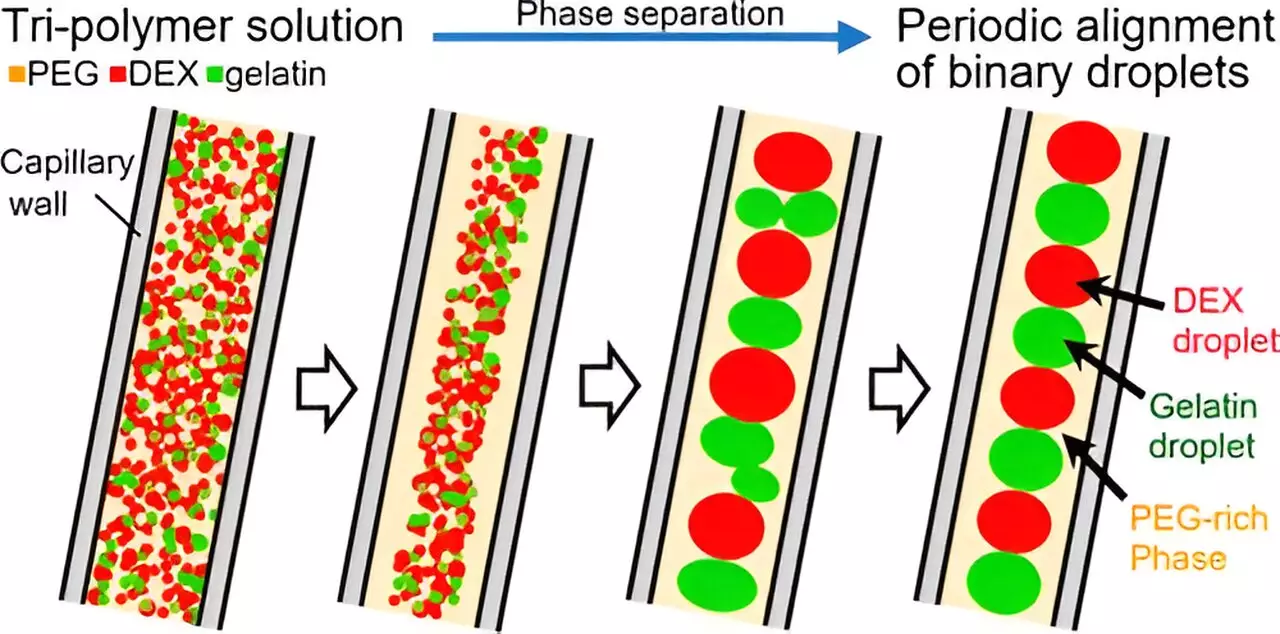Polymer systems have the unique ability to spontaneously induce emulsion or microdroplets through mechanical mixing, creating an intermediate state of macroscopic phase separation. However, the challenge lies in the nonuniform size and random spatial arrangement of these droplets, which tend to grow larger over time in a process known as coarsening. Researchers have attempted to address this issue by rapidly lowering the temperature, but the uniformity of the droplets remains a concern. The potential applications of uniformly arranged, homogeneous droplets, which can encapsulate substrates such as DNA and medicines, are significant in drug delivery and synthetic cell creation.
A study published in ACS Macro Letters by a research team led by Ph.D. student Mayu Shono from Doshisha University reveals a groundbreaking discovery in the self-organization of microdroplets. The team observed the spontaneous generation of a homogeneous spatial pattern of microdroplets through phase separation of a polymer solution inside a glass capillary tube. The researchers found that the droplets aligned themselves in a periodic pattern within the polymer solution, creating a stable arrangement that lasted for hours.
Experimental Procedure
In their experiments, the researchers prepared aqueous tripolymer solutions combining polyethylene-glycol (PEG), dextran (DEX), and gelatin in specific weight ratios. By labeling DEX and gelatin with fluorescent markers, they were able to distinguish the different components in the sample. The solution was drawn into PEG-coated capillary tubes, where PEG immediately separated from the solution due to preferential attachment to the capillary’s surface. The DEX and gelatin phases formed droplets that aligned themselves linearly in the capillary, resulting in a self-organized pattern surrounded by a PEG-rich phase.
The researchers’ findings shed light on a novel phenomenon in self-organization, distinct from other systems due to its spontaneous nature without the exchange of materials or energy. Through numerical simulations and modifications to theoretical models, the researchers were able to reproduce the observed micropatterns, providing valuable insights into the self-assembly of biological molecules. This innovative methodology offers superior advantages over current microfluidics, enabling the preservation of uniform droplets for extended periods.
The implications of this research are far-reaching, with potential applications in targeted drug delivery and the production of macromolecules using protocells. By studying micropatterns in polymer systems, researchers can gain valuable insights into the mechanisms underlying the self-assembly of biological molecules. This research opens up new avenues for exploring the self-organization of microdroplets and its implications in various fields ranging from biotechnology to material science.
The self-organization of microdroplets in polymer systems represents a significant advancement in understanding complex biological processes and creating functional materials for diverse applications. Through innovative research and experimental techniques, researchers are uncovering novel phenomena that hold promise for the development of cutting-edge technologies and therapies. The journey towards unlocking the full potential of self-assembling systems is ongoing, with each discovery bringing us closer to harnessing the power of self-organization in designing advanced materials and biological structures.


Leave a Reply